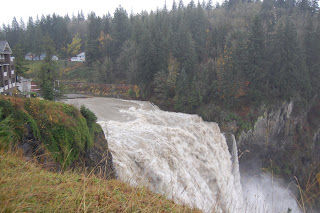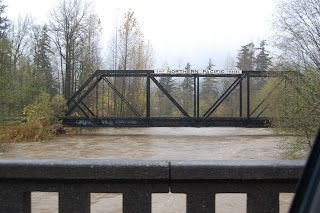 Last week was trying. Near-record rains again raised awareness about how vulnerable any museum collection is to the natural environment. Earthquakes, ash from volcanic eruptions, and flooding are the top threats facing the Northwest Railway Museum collection. And this week forecasters were calling for the “perfect storm” as a duo of tropical storms appeared to sequentially target the Snoqualmie Valley. As late as noon on Wednesday, November 12 everyone was expecting more than 10 inches of rain in a 24-hour period and USGS flow forecasts were calling for a river crest of 63,000 cubic feet per second (CFS). Never before had such flows been forecast and Museum staff began to wonder if water would actually get into the buildings for the first time ever. (The Snoqualmie Depot was built in 1890 and there is no record of water ever getting into the structure.) Thankfully, the storms ended up tracking differently and river flow peaked at about 45,000 CFS, but still over ten times the normal November flow.
Last week was trying. Near-record rains again raised awareness about how vulnerable any museum collection is to the natural environment. Earthquakes, ash from volcanic eruptions, and flooding are the top threats facing the Northwest Railway Museum collection. And this week forecasters were calling for the “perfect storm” as a duo of tropical storms appeared to sequentially target the Snoqualmie Valley. As late as noon on Wednesday, November 12 everyone was expecting more than 10 inches of rain in a 24-hour period and USGS flow forecasts were calling for a river crest of 63,000 cubic feet per second (CFS). Never before had such flows been forecast and Museum staff began to wonder if water would actually get into the buildings for the first time ever. (The Snoqualmie Depot was built in 1890 and there is no record of water ever getting into the structure.) Thankfully, the storms ended up tracking differently and river flow peaked at about 45,000 CFS, but still over ten times the normal November flow.
 For the Museum, the result was no damage. However when the threat was first forecast, Museum management made an immediate decision to close the museum and focus on mitigation: ensure nothing was sitting directly on the floor in either the Snoqualmie Depot or the Conservation and Restoration Center, and that anything vulnerable such as books and papers were at least six inches above the floor. Everyone is happy that record flooding never materialized but it is apparent that area storms are increasing in severity above storms of the last century. Planning for the future will require an assumption that storm related impacts will be greater, but by how much? The same question is on the minds of many museum managers across the region.
For the Museum, the result was no damage. However when the threat was first forecast, Museum management made an immediate decision to close the museum and focus on mitigation: ensure nothing was sitting directly on the floor in either the Snoqualmie Depot or the Conservation and Restoration Center, and that anything vulnerable such as books and papers were at least six inches above the floor. Everyone is happy that record flooding never materialized but it is apparent that area storms are increasing in severity above storms of the last century. Planning for the future will require an assumption that storm related impacts will be greater, but by how much? The same question is on the minds of many museum managers across the region.
Included images: Snoqualmie Falls at 45,000 cfs with Museum’s railway visible on the far river bank; South Fork at 6,000 cfs flowing below Museum’s bridge 35.

